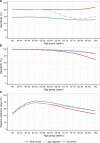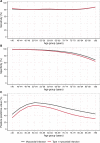Influence of Age on the Diagnosis of Myocardial Infarction
- PMID: 36106552
- PMCID: PMC9555758
- DOI: 10.1161/CIRCULATIONAHA.122.059994
Influence of Age on the Diagnosis of Myocardial Infarction
Abstract
Background: The 99th centile of cardiac troponin, derived from a healthy reference population, is recommended as the diagnostic threshold for myocardial infarction, but troponin concentrations are strongly influenced by age. Our aim was to assess the diagnostic performance of cardiac troponin in older patients presenting with suspected myocardial infarction.
Methods: In a secondary analysis of a multicenter trial of consecutive patients with suspected myocardial infarction, we assessed the diagnostic accuracy of high-sensitivity cardiac troponin I at presentation for the diagnosis of type 1, type 2, or type 4b myocardial infarction across 3 age groups (<50, 50-74, and ≥75 years) using guideline-recommended sex-specific and age-adjusted 99th centile thresholds.
Results: In 46 435 consecutive patients aged 18 to 108 years (mean, 61±17 years), 5216 (11%) had a diagnosis of myocardial infarction. In patients <50 (n=12 379), 50 to 74 (n=22 380), and ≥75 (n=11 676) years, the sensitivity of the guideline-recommended threshold was similar at 79.2% (95% CI, 75.5-82.9), 80.6% (95% CI, 79.2-82.1), and 81.6% (95% CI, 79.8-83.2), respectively. The specificity decreased with advancing age from 98.3% (95% CI, 98.1-98.5) to 95.5% (95% CI, 95.2-95.8), and 82.6% (95% CI, 81.9-83.4). The use of age-adjusted 99th centile thresholds improved the specificity (91.3% [90.8%-91.9%] versus 82.6% [95% CI, 81.9%-83.4%]) and positive predictive value (59.3% [57.0%-61.5%] versus 51.5% [49.9%-53.3%]) for myocardial infarction in patients ≥75 years but failed to prevent the decrease in either parameter with increasing age and resulted in a marked reduction in sensitivity compared with the use of the guideline-recommended threshold (55.9% [53.6%-57.9%] versus 81.6% [79.8%-83.3%].
Conclusions: Age alters the diagnostic performance of cardiac troponin, with reduced specificity and positive predictive value in older patients when applying the guideline-recommended or age-adjusted 99th centiles. Individualized diagnostic approaches rather than the adjustment of binary thresholds are needed in an aging population.
Keywords: acute coronary syndrome; aging; frail elderly; myocardial infarction; troponin.
Figures



Comment in
-
Letter by Chen et al Regarding Article, "Influence of Age on the Diagnosis of Myocardial Infarction".Circulation. 2023 Apr 25;147(17):1314. doi: 10.1161/CIRCULATIONAHA.122.063067. Epub 2023 Apr 24. Circulation. 2023. PMID: 37093969 No abstract available.
-
Response by Lowry et al to Letter Regarding Article, "Influence of Age on the Diagnosis of Myocardial Infarction".Circulation. 2023 Apr 25;147(17):1315-1316. doi: 10.1161/CIRCULATIONAHA.123.064130. Epub 2023 Apr 24. Circulation. 2023. PMID: 37093971 No abstract available.
-
Letter by Gibson and McEvoy Regarding Article, "Influence of Age on the Diagnosis of Myocardial Infarction".Circulation. 2023 Apr 25;147(17):1312-1313. doi: 10.1161/CIRCULATIONAHA.122.062836. Epub 2023 Apr 24. Circulation. 2023. PMID: 37093972 No abstract available.
References
-
- Thygesen K, Alpert JS, Jaffe AS, Chaitman BR, Bax JJ, Morrow DA, White HD; ESC Scientific Document Group. Fourth universal definition of myocardial infarction (2018). Eur Heart J. 2019;40:237–269. - PubMed
-
- Apple FS, Ler R, Murakami MM. Determination of 19 cardiac troponin I and T assay 99th percentile values from a common presumably healthy population. Clin Chem. 2012;58:1574–1581. doi: 10.1373/clinchem.2012.192716 - PubMed
-
- Welsh P, Preiss D, Shah ASV, McAllister D, Briggs A, Boachie C, McConnachie A, Hayward C, Padmanabhan S, Welsh C, et al.. Comparison between high-sensitivity cardiac troponin t and cardiac troponin I in a large general population cohort. Clin Chem. 2018;64:1607–1616. doi: 10.1373/clinchem.2018.292086 - PMC - PubMed
-
- Gore MO, Seliger SL, Defilippi CR, Nambi V, Christenson RH, Hashim IA, Hoogeveen RC, Ayers CR, Sun W, McGuire DK, et al.. Age- and sex-dependent upper reference limits for the high-sensitivity cardiac troponin T assay. J Am Coll Cardiol. 2014;63:1441–1448. doi: 10.1016/j.jacc.2013.12.032 - PMC - PubMed
-
- Collinson PO, Heung YM, Gaze D, Boa F, Senior R, Christenson R, Apple FS. Influence of population selection on the 99th percentile reference value for cardiac troponin assays. Clin Chem. 2012;58:219–225. doi: 10.1373/clinchem.2011.171082 - PubMed
Publication types
MeSH terms
Substances
Grants and funding
- RG/16/10/32375/BHF_/British Heart Foundation/United Kingdom
- CH/F/21/90010/BHF_/British Heart Foundation/United Kingdom
- FS/19/17/34172/BHF_/British Heart Foundation/United Kingdom
- MR/W000598/1/MRC_/Medical Research Council/United Kingdom
- MR/V007254/1/MRC_/Medical Research Council/United Kingdom
- FS/CRTF/21/24273/BHF_/British Heart Foundation/United Kingdom
- MR/V007017/1/MRC_/Medical Research Council/United Kingdom
- CH/09/002/26360/BHF_/British Heart Foundation/United Kingdom
- FS/18/25/33454/BHF_/British Heart Foundation/United Kingdom
- RG/20/10/34966/BHF_/British Heart Foundation/United Kingdom
LinkOut - more resources
Full Text Sources
Medical
Research Materials

